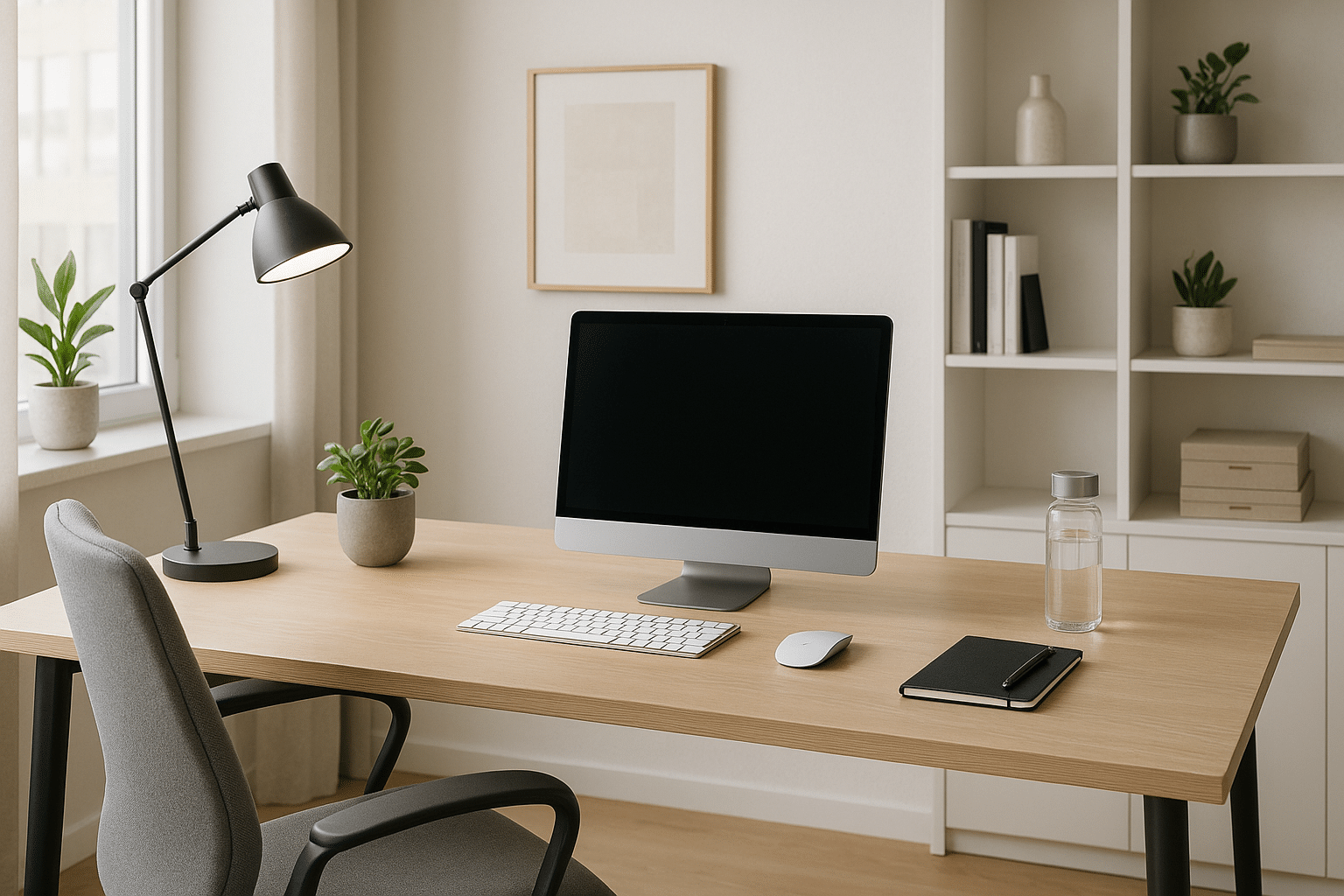If you’ve ever found yourself desperately glancing at the clock, grappling with your concentration, or endlessly flicking between tabs while attempting to work, then you’re not alone. These experiences are universal, an unfortunate side effect of our increasingly interconnected, hyperactive world. In our quest for productivity, these distractions have become our biggest adversary. The solution? Designing your ultimate distraction-free workspace. 👩💻
Before we dive into the mechanics of crafting the ideal work environment, it’s important to understand what we’re up against. Distractions are not merely a product of our physical environment; they also spawn from our cognitive landscape. They are external stimuli that divert our attention from the task at hand, resulting in a fractured focus and diminished productivity. 😵💫
Fortunately, we are not helpless in the face of these productivity killers. This article will delve deep into the strategies to combat both physical and mental distractions, providing you with actionable insights into designing the ultimate workspace that enhances productivity, reduces stress, and fosters creativity. 🚀
Physical Environment: More than Just Aesthetics
Our first stop on this journey towards a distraction-free workspace is the physical environment. While it’s tempting to dismiss the influence of our surroundings, research consistently shows that our physical workspace plays a critical role in our productivity levels. From the lighting and noise levels to the ergonomics of your chair, every element in your workspace contributes to your work output.
Mental Landscape: The Hidden Battle
Even with the perfect physical setup, distractions can still penetrate our defenses via our mental landscape. This section will delve into the cognitive science behind distractions, explaining why our brain seems to favor that cute cat video over the pressing deadline. More importantly, we’ll provide you with techniques to armor your mind against these intrusions, helping you maintain focus and boost productivity. 🧠💪
Tools and Techniques: Armoring Your Workspace
Now that we understand what we’re fighting against, it’s time to equip ourselves with the right tools and techniques. This section will be your guide to the plethora of productivity apps, noise-canceling headphones, and even certain kinds of music designed to create a work environment that is both pleasant and conducive to concentration. 🎧🎶
Sustaining the Change: Building a Habit
Finally, we’ll talk about how to make these changes stick. After all, a distraction-free workspace isn’t much use if you can’t maintain the habits necessary to keep it that way. Here we will delve into the psychology of habit formation, providing you with actionable tips to sustain your newly minted workspace. 🔄
This article aims to provide you with a comprehensive guide to creating a workspace that is not only free from distractions but is also a place where you can thrive and produce your best work. We’ll explore the latest research, draw on expert advice, and give you practical tips that you can implement immediately. So, buckle up and get ready to boost your productivity as we embark on this exciting journey towards creating your ultimate distraction-free workspace. 🎯
The Science Behind a Productive Workspace
The modern-day workspace can either be a productivity paradise or a distraction-riddled nightmare. The difference often lies in the workspace design and environment. As much as technology is integral to our lives and businesses, it can be a double-edged sword. When misused or not properly managed, it can be a major source of distraction. On the flip side, a well-designed workspace can boost productivity, foster creativity, and increase overall job satisfaction.
Understanding the science behind a productive workspace helps unravel the relationship between our physical environment and our mental state. According to environmental psychology, our surroundings can influence our emotions, thoughts, and behaviors, affecting our performance and productivity. This perspective emphasizes the importance of designing a workspace that promotes focus and efficiency.
With the proliferation of remote work due to the COVID-19 pandemic, the need to create a distraction-free workspace at home has become a pressing issue. In this article, we’ll explore practical strategies to design your ultimate distraction-free workspace. We’ll delve into factors like workspace ergonomics, noise management, and the role of technology in creating a productive work environment.
Workspace Ergonomics: The Key to Physical Comfort and Efficiency
Workspace ergonomics is the science of designing a workplace to fit the user’s needs. It aims to create a workspace that accommodates the user’s physical condition and job demands, minimizing discomfort and the risk of injury. A well-optimized workspace can improve productivity and job satisfaction, reduce stress and fatigue, and prevent health issues like repetitive strain injuries and musculoskeletal disorders.
Essential components of workspace ergonomics include the right furniture, proper lighting, and thoughtful layout. The workstation should have an adjustable chair with good back support and a desk at an appropriate height. The computer screen should be at eye level, with the keyboard and mouse within easy reach. Natural light is best, but if that’s not possible, a well-placed desk lamp can help prevent eye strain.
Check out the video “Office Ergonomics – 5 Keys to a Healthy Workspace” from the YouTube channel “UC Berkeley University Health Services” for a detailed guide on setting up an ergonomic workstation.
Comparing Ergonomic Office Chairs
| Brand | Model | Features | Price |
|---|---|---|---|
| Herman Miller | Aeron Chair | Adjustable seat height, tilt, and arms; Excellent lumbar support | $$$$ |
| Steelcase | Gesture Chair | Flexible seat edge; 360° arm movement; Adjustable seat depth and height | $$$$ |
| Autonomous | ErgoChair 2 | Adjustable headrest, backrest, seat height, and tilt; Built-in lumbar support | $$$ |
Noise Management: Finding Your Productivity Soundtrack
Sound can significantly impact your ability to focus and be productive. While some people thrive in noisy environments, others need complete silence to concentrate. For the latter group, noise can be a significant distraction. Whether it’s chatty coworkers, background chatter in a coffee shop, or the sound of traffic from an open window, unwanted noise can disrupt your concentration and reduce your productivity.
The good news is, there are strategies and tools to help manage noise in your workspace. Noise-canceling headphones can be a great investment for those working in noisy environments. Additionally, apps and websites offer a range of ambient sounds, from white noise to nature sounds and even “office noise,” that can help mask distracting background sounds. It’s all about finding the right “productivity soundtrack” that suits you.
Another solution is soundproofing your workspace. While this can require a bit more investment, it may be worth considering if you’re working from home and have a dedicated office space. Simple adjustments like adding a door sweep, installing sound-absorbing panels, or using a white noise machine can make a big difference.
Choosing Noise-Canceling Headphones
| Brand | Model | Features | Price |
|---|---|---|---|
| Bose | QuietComfort 35 II | World-class noise cancellation; Alexa-enabled; Bluetooth connectivity | $$$$ |
| Sony | WH-1000XM4 | Industry-leading noise cancellation; Touch sensor controls; Speak-to-chat technology | $$$$ |
| Anker | Soundcore Life Q20 | Active noise cancellation; 40-hour playtime; BassUp technology | $$ |
Technology: Leveraging Tools for a Distraction-Free Workspace
Technology, when used correctly, can be a powerful ally in creating a distraction-free workspace. There are numerous tools and apps available designed to help you manage your time, stay organized, and keep distractions at bay. Productivity apps like Asana or Trello can help you manage your tasks and projects, while apps like Forest or RescueTime can help you stay focused and avoid distractions.
It’s also important to consider the role of hardware in your workspace. For example, using multiple monitors can increase productivity by allowing you to have multiple windows open simultaneously, reducing the need to switch back and forth between tabs or apps. Similarly, a good quality keyboard and mouse can increase comfort and efficiency.
Remember, the goal of using technology in your workspace should be to assist you, not distract you. Be mindful of potential digital distractions like social media notifications, email alerts, and other interruptions that can derail your focus. Take control of your technology, don’t let it control you.
Top 5 Productivity Apps
- Asana: A project management tool that helps teams organize, track, and manage their work.
- Trello: A task management app that gives you a visual overview of what is being worked on and who is working on it.
- Evernote: A note-taking app that makes it easy to organize your personal and professional projects.
- Slack: A collaboration hub that connects your team with the people and tools they work with every day.
- RescueTime: An app that helps you understand your daily habits so you can focus and be more productive.
Implementing these strategies and tools can help you design your ultimate distraction-free workspace. But remember, what works for one person might not work for another. Experiment with different setups and find the one that works best for you. Good luck, and here’s to your productivity!

Conclusion
In wrapping up this deep dive into the intricate world of Information Technology (IT) and Engineering, I hope it is now clearer how these two realms intersect and influence our daily lives. This article has illuminated several key concepts, beginning with a comprehensive overview of IT, its various branches, and the primary role it plays in modern businesses. We then delved into the field of engineering, with a particular focus on Software Engineering – an area with which I have substantial professional experience.
We touched on the essential software development processes, from initial requirement gathering to the final stages of testing and maintenance, emphasizing the critical role each plays in the creation of reliable, high-quality software products. It was then important to underscore the role of project management in software development, exploring the Agile methodology as a highly effective approach widely adopted across the industry.
The topic of Cybersecurity was another critical point covered, given its increasing importance in our hyper-connected world. We discussed common threats, defense strategies, and the need for a robust cybersecurity framework to safeguard valuable data.
However, all these technical concepts would be futile without a competent workforce. Therefore, we dedicated a significant portion of the discussion to exploring the roles, responsibilities, and essential skills of IT and Engineering professionals. We also highlighted the continuous learning and adaptability required to stay abreast in these rapidly evolving fields.
In this final section, we focused on the ever-evolving trends in IT and Engineering, discussing how Artificial Intelligence (AI), Machine Learning (ML), and Internet of Things (IoT) are revolutionizing the landscape. These advanced technologies are not only enhancing operational efficiency but also propelling unprecedented innovation and progress across various sectors.
I trust that this comprehensive guide has not only enhanced your understanding of IT and Engineering but has also demonstrated the immense potential and promise these fields hold. Whether you are a student considering a career in these fields, a professional seeking to enhance your knowledge, or a curious mind interested in the technologies shaping our world, I encourage you to delve deeper, ask questions, and continue learning.
As Albert Einstein once said, “The important thing is not to stop questioning. Curiosity has its own reason for existing.” (source: Goodreads)
So, let’s keep the conversation going. Share this article with your colleagues, discuss it with your peers, apply the concepts in your work, and don’t hesitate to drop a comment below. I look forward to engaging with your thoughts and questions. And remember, in this era of rapid technological progress, the best investment you can make is in your knowledge.
Stay curious and keep learning. 👩💻🌐🚀
Remember, if you have any doubts or need further clarification on any point, feel free to leave a comment. Alternatively, you can also use the search function on this blog to find related articles or explore the various categories and tags to discover more insightful content.
Remember to share this article on your social media platforms to spread the knowledge. Let’s empower each other through learning. 👍🌎
Source:
Goodreads



